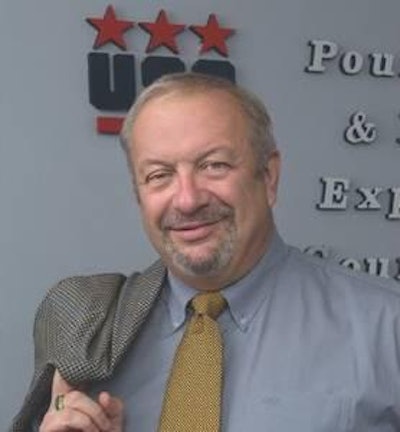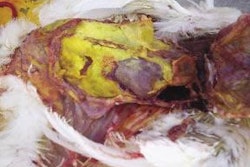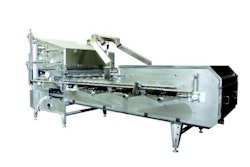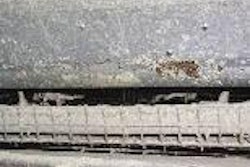
Jim Sumner is a long-standing member of either the USDA Agriculture Technical Advisory Committee or the Agriculture Policy Advisory Committee for Trade which are instrumental in advancing U.S. poultry industry interests in international trade negotiations.
Jim was elected as the first president of the International Poultry Council, which he helped found in 2006. He serves as the Export Advisor to the American Egg Board and is Chairman of the Trade and Executive Committees of the International Egg Commission. Sumner holds a degree in journalism from Southern Illinois University and has undertaken post graduate work in public relations. The USAPEEC is a non-profit organization representing 210 poultry processing companies, traders and affiliated organizations involved in exports. The Council receives funds from the Foreign Agriculture Service of the USDA, State and National Industry Commodity associations including a modest but welcome contribution from the AEB.
Jim Sumner set aside time from his demanding travel and meeting schedule for Egg Industry to review aspects of export promotion.
Egg Industry: Jim, please share some of the export successes achieved by USAPEEC over the past few years.
Jim Sumner: 2007 was an excellent year for shell egg exports due in part to a non-recurring demand from the Middle East and the EU. We are, however, currently maintaining a steady volume for egg products in line with traditional volumes.
Over a year ago, we brought on board our own economist, Dr. Renan Zhuang, who calculates that export activities, which represent 3% of total U.S. shell egg equivalents, are contributing materially to industry earnings.
EI: What barriers do we face in expanding exports?
JS: The cost of transport-both from inland plants of origin to our coasts-and sea freight have been extremely high. The U.S. dollar is strengthening against other currencies, which also impairs our ability to compete. A global economic crisis has reduced demand in many of the countries to which we traditionally export. But as bad as the economic and feed grain situation is in the U.S., it's usually even worse outside the U.S., giving us new market opportunities around the world.
EI: How is USAPEEC addressing these problems?
JS: We are constantly searching for new market opportunities and are working hard to maintain traditional importers. We have recently staged promotional activities in Hong Kong and Japan. Our emphasis will continue to be on egg products, especially dried eggs which do not require refrigeration.
Starting about a year ago we began incurring tremendous problems obtaining refrigerated containers for shell eggs. With the down-turn in global trade and improved logistics, the availability of refrigerated containers is now much less of an issue.
Paradoxically, contamination of the food chain with melamine in Southeast Asia has resulted in renewed appreciation for the inherent quality and safety of U.S. poultry meat and eggs. An unfortunate result of the recent revelations has been the imposition of stricter regulations and requirement for assays to confirm freedom from adulterants.
EI: Are there any new markets opening up?
JS: Mexico has emerged as a significant consumer of further-processed egg products. Our local representative Jose Manuel Sampeiro (our Señor Huevo!) has generated demand in a number of markets in our southern neighbor. We have commenced exporting pasteurized in-shell eggs since conventional product cannot be exported to Mexico, which, like many countries, sees no need in maintaining a cold chain for shell eggs.
EI: Are there any technical restraints to improving quality of shell eggs exports?
JS: The industry should carefully evaluate the specifications for egg export boxes since overseas shipment involves many points of handling, requiring more substantial protection than for domestic product.
EI: Are there any other potential markets for shell eggs or products?
JS: We are showing increases in shipments of shell eggs into the Caribbean Basin. Cuba may again emerge as an important market, along with other countries which are dependent on importing feed grains which includes most of the Caribbean.
Canada imports U.S. shell eggs to balance demand. It is inevitable that their quota system which artificially restricts domestic production and imports of agricultural products will ultimately be eliminated creating opportunities for U.S. exporters and possibly joint ventures.
EI: How do you view the future of exports of shell eggs and products?
JS: I'm convinced that we will continue to make incremental improvements in volume across the board with the largest growth area in dried egg components. Cumulative exports of egg products for the first seven months of 2008 attained $51.7 million, which is a 20% increase over the first seven months of 2007.
Japan increased purchases and it is expected that a similar trend will be seen in 2009 based on quality and safety considerations. Dried egg product is used extensively in Japan for noodles, mayonnaise and for traditional dishes.
Germany, Mexico and Denmark also increased imports which is a gratifying trend. It is possible that the U.S. industry may become more export-oriented.
As with many exported products, it is necessary to supply in accordance with customers' specifications. It has been suggested that we may consider producing brown eggs from caged hens since consumers in many of our importing nations discriminate against white shells. If we are to serve certain Moslem markets which continue to grow throughout the world, it may be necessary to feed all-vegetable diets to conform to Halal requirements; that is a decision our egg producers will need to make. Certain markets also require jet printing or etching of shells using languages and codes.
EI: USAPEEC maintains offices in 13 foreign countries and your Georgia-based staff is constantly traveling to promotional events, international meetings and for consultation with officials in importing countries. Is the Council adequately funded?
JS: We are supported in part by our members and by various federal agencies and from state and national industry association grants. We receive a modest contribution from the American Egg Board (AEB) which is derived from check-off payments.
Unfortunately, many of the grassroots producers who are sometimes polled on the use of promotion funds are frequently unaware of the direct contribution made by USAPEEC to export promotion and the beneficial effect this has on all producers, irrespective of their participation in exports.

















